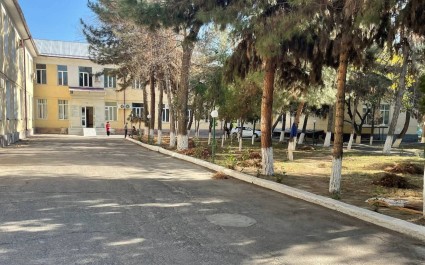Saidazim Sharipov, Deputy Director for Urban Planning and Scientific Projects of the ToshkentboshplanLITI Institute of Design and Research, spoke at a press conference on Saturday about the details of the draft master plan of Tashkent until 2045.
Over the course of two years foreign and local designers, economists, environmentalists, transport workers and urbanists have been working on the draft master plan at ToshkentboshplanLITI. The main consultant of the project is Bart Muskens, an urbanist from the Netherlands. He has worked on projects in urban strategies and regional economic development planning in his country.
The Institute also attracted specialists from Turkey, including the founder of Kentsel Strateji, Ali Faruk Goksu. He has developed vision plans for the development of more than 80 territories in Turkey.
What Tashkent’s draft master plan is about
The draft master plan of Tashkent is the capital’s development strategy. To date, scenarios for the development of the city, the areas, where construction, reconstruction, renovation or conservation are required, have been approved.
At the next stage ToshkentboshplanLITI (design institute) will develop rules for the development of these territories. They will include requirements for the number of storeys of buildings in various areas of the city, population density, landscaping, development of public transport, parking and social services. It is possible to update urban planning norms. The deadline for the development of rules has not yet been set, Saidazim Sharipov said.
According to him, the next step will be the development of master plans for seperate areas in accordance with the rules. This task can be transferred to private companies subject to compliance with the requirements of the regulator, said Saidazim Sharipov.
Two centers and five development areas
The developers of the draft proposed to develop two large centers in the city. They will be the existing center and the city of New Tashkent, which is planned to be built to the east of the capital.
In addition, it is proposed to create five development areas with four sub-centers and their own green belt, which will be a continuation of the green belt along the Tashkent Ring Road (TRR). Subcenters will be located on two axes parallel to each other.
Sub-centers for the development of territories are transport hubs around which service centers will be formed. For example, today such centers are the Chilanzar and Buyuk Ipak Yuli metro stations or the Universam shopping complex in Yunusabad district. Due to the fact that these centers are actually the only ones in the area today, the load on the infrastructure in the district of these places is very high.
In order to reduce this burden and evenly provide the population of the district with access to these places, it is proposed to create four such sub-centers in each of the five development areas.
Underdeveloped areas are defined as development territories, said Saidazim Sharipov. For example, Yunusabad, Chilanzar, Sergeli and Mirzo-Ulugbek districts are not such.
Transport accessibility
The main attention of the developers has been given to the climate. Due to the fact that it is impossible to improve air quality without the development of public transport, the city plans to expand the network so that 95% of the population can reach the nearest public transport stop in 15 minutes.
“Our focus is mainly on fast public transport. Cyrrently, it is the subway,” Saidazim Sharipov said.
However, the existing lines cover the population mainly in the center. According to ToshkentboshplanLITI, today 37% of the population of Tashkent live within a 15-minute walk from metro stations. 78% of the population can reach the nearest metro station in 15 minutes by bike or electric scooter.
The strategy involves the completion of the construction of the planned metro lines, as well as the construction of a 10 km monorail from Rohat circle to Yangi Uzbekiston park, 100 km of dedicated lines for a high-speed bus or tram, and 28 transport hubs.
Saidazim Sharipov explained that the authors of the draft proposed the construction of dedicated lines for a high-speed bus, and not a tram network due to the high cost of the latter.
It should be noted that in terms of the life span - on the horizon starting from about 15 years - the tram is cheaper due to the longer service life of the cars and its carrying characteristics. In addition, trams pollute the environment less than electric buses: mechanical abrasive materials from various surfaces (roads, tires, brake wear) are one of the sources of fine PM particles.
The developers of the plan also determined the categories of urbanized areas of the capital. These are the city center inside the Small Ring Road (SRR) with a population of 600,000 people, the territory between the SRR and the TRR with a population of more than 2 million people, as well as suburbs, whose 300,000 people do not legally live in the capital, but whose daily life is concentrated in the city. For the development of Tashkent, it is necessary to ensure transport accessibility for the entire population of the agglomeration.
Therefore, the existing railways are planned to be used for the development of electric trains. To do this, it is necessary to free the existing industrial territories and move them out of the city. The vacated areas will be transferred to the balance of the city. They are used for the further development of Tashkent, and electric trains will be launched on the railway.
Freight trains will be allowed to bypass the city. Only Tashkent Northern and Chuqursoy stations will continue to receive them. However, in order not to disturb the citizens, the work will be carried out at night.
“In order to launch electric trains and transfer freight trains outside the city, it is necessary to build only 32 km of the railway. To put modern electric trains on these routes, it is necessary to modernize the road. But these are not such big expenses, because the most important thing - the network - we already have, Saidazim Sharipov said.
At the entrances to the city, free intercepting parking lots with service centers will also be built. With the introduction of paid parking in the city center and the development of public transport, motorists will be more willing to leave their car in one of the parking lots and go to the city by public transport, rather than prefer to pay for parking in the city center.
Thus, the stops of the main public transport lines will be located within a 15-minute walk from the places of residence of 73% of the population. And 95% of the residents of the capital will be able to reach them by bicycle or electric scooter within 15 minutes.
At the same time, despite all the assurances about the prioritization of public transport, the developers of the master plan are not going to deny the residents of the city the ownership of a parking space. Thus, according to the proposed standards, parking lots at multi-apartment buildings should be built on the basis of one parking space per apartment.
Tashkent’s construction development strategy
It will not be possible to move all the construction projects outside Tashkent. This contradicts the very idea of вАЛвАЛdevelopment and growth of the city. It is planned to stop the construction of large facilities (administrative buildings, universities) in the city center to preserve its architectural appearance. According to Saidazim Sharipov, the architectural appearance of Tashkent is a traditional mahalla, architectural ensembles on Bobur Street, Shota Rustaveli and Navoi. When the allocation of land for the construction of large facilities will be terminated, it is not known.
Today, the bulk of the population is concentrated in areas with high building density: in Yunusabad, Chilanzar, Sergeli and Mirzo-Ulugbek districts. The low population density is due to low-rise buildings - traditional mahallas.
The lowest population density is observed in the southeastern part of the capital in the territories recently annexed to the city. There is development potential here. In addition, according to the analysis of the development of communications, there is potential for construction in the southeast.
“The northwestern part of the city is already quite developed,” said Saidazim Sharipov. “In addition, this part of Tashkent is located in a 9-point seismic zone, and the southeastern part is in an 8-point seismic zone.”
At the same time, in the north-west of the capital, in Almazar, Shaykhantakhur and Uchtepa districts, there are many traditional mahallas. They are not planned to be demolished and built up with high-rise housing, because the modernization of utilities here will cost more than in the southeast.
The developers of the master plan identified three main directions of the development strategy for the development of the capital.
Reconstruction
The main arae of the city's development is reconstruction. It distinguishes four categories of territories.
The first category is areas with sufficient infrastructure. These are micro-districts and recently commissioned districts. Construction will be prohibited here.
The second category is territories where it is necessary to build kindergartens, schools, green areas. Basically, these sites have a low population density, as they are mostly represented by one-story individual buildings.
Due to the chaotic growth in such mahallas, there is poor transport connectivity, few streets, and no social centers. According to Saidazim Sharipov, such territories occupy less than half of the area of вАЛвАЛthe capital, but a significant part of it. This suggests that the city is being used inefficiently.
However, they are not planned to be demolished due to poorly developed engineering communications. To provide the population of these areas with transport accessibility, bikesharing points will be built in the centers of these mahallas. Residents will be able to rent a bicycle or a scooter or purchase one to get to the nearest bus stop within 15 minutes.
However, a slight increase in building density in these areas is already observed. High-rise housing is being built along the main streets.
The third category is territories where a partial increase in population density is needed. This means that the number of storeys can increase, but only up to certain limits, so as not to create an additional load on the existing infrastructure.
The fourth category is territories that are already in need of restructuring. Mahallas, micro-districts that were built at the earliest time, and today are in disrepair. They will develop in a new way.
Renovation
Territories that will be transformed in the future will fall under renovation. These are mainly new territories that have recently been included in the territory of Tashkent, as well as 6,000 hectares of land used by industrial enterprises.
Conservation
All green areas and embankments. They are planned only to be improved, with no construction envisaged.
The average number of storeys of buildings in Tashkent
An analysis carried out in one of the mahallas of Tashkent with one-story buildings showed that the most common options are when the ratio of the total building area to the land area occupied by the building is 1:1 or 1:0.75. That is, if the area of вАЛвАЛвАЛвАЛa one-story house is 200 square meters. m, then it occupies 200 sq.m of land, or the area of вАЛвАЛa two-story house is 400 sq.m. m and occupies 300 sq.m of land.
This ratio is called the ratio of building area to land area ratio. The formula is often used in urban planning and city planning to determine the density of a city.
“We analyzed one mahalla. In it, 69% of the territory is occupied by buildings, and 29% by roads. The population density is 114 people per hectare. Approximately 80-90% of one-story mahallas have such a structure. It is necessary to find a balance between the ratio of the building area and the total area of вАЛвАЛthe territory, so that there are not only houses and roads, but also services and green areas,” Saidazim Sharipov said.
According to him, if the development is represented by 5-6-storey buildings, then 25% of the territory can be allocated for housing, with the improvement of infrastructure, 12% will be allocated for roads, green areas will be placed on 25% of the area, kindergartens and the center will be equally divided on 24%. mahallas with a variety of services, and 15% - schools. At the same time, the population density will increase by more than 5 times to 600 people per hectare.
“Consolidation will allow more space for public areas. To achieve this, it is necessary to abandon individual housing, the specialist noted. “5-6 floors is the optimal number of storeys, in which people have sufficient social connection: they communicate with each other, let their children go outside.”
Saidazim Sharipov added that individual housing essentially deprives the population of basic social benefits. At the same time, it will not work to deprive residents of the opportunity to live in private homes, the specialist said.
“The peculiarity of our region, our culture is that people are used to having their own backyard. Therefore, during the Soviet era, experimental buildings were built, such as Zhemchug, and areas with large courtyards, like C-27. Architects must give a solution to the demands of the people. If such decisions are made, people will gradually move to apartments, because they need to pay land tax, take care of the garden. Costs will rise, but there will be people who would never trade their patio for an apartment.”
New Tashkent and Yangi Shahar cities
According to the presented forecast, by 2041 the Tashkent’s population will increase from the current 2.96 million to over 5.15 million people. According to Saidazim Sharipov, the apartment buildings currently under construction will be able to partially meet the demand for housing of the growing population. They will accommodate about 80 thousand people.
The draft master plan until 2045 assumes that the city of New Tashkent will be built to the east of the capital, between the Chirchik and Karasu rivers. It will cover an area of вАЛвАЛ20,000 hectares. However, by 2045 only 6,000 hectares are planned to be developed. Housing for 500 thousand people will be built here.
“Building up an area of вАЛвАЛ20,000 hectares by 2045 is, to put it mildly, a difficult task. In addition, there are fertile lands. Whether to use these lands for construction will be decided by urban planners in 2045,” Saidazim Sharipov said.
“The place of New Tashkent is unique. There is a different ecology, landscapes, peculiar channels and flora. In our project, we want to preserve these qualities and integrate them into the projected city,” he added.
In Yangikhayot district of the capital, on an area of вАЛвАЛ6,000 hectares, it is planned to build a New City - Yangi Shahar. Until 2045, housing for 500 thousand people can be built here. Potentially, the city will be able to accommodate 910 thousand people.
Green Concept
The developers of the draft found out that in the existing green zones the air temperature is 5 degrees lower than in squares and streets with sparse vegetation.
In this regard, ToshkentboshplanLITI identified five green arteries of the city along the five canals that cut through Tashkent. Embankments of the arteries will be landscaped and planted with trees. In addition, a “green ring” with a length of 130 km will be planted along the TRR.
“This is a small figure, given that Africa is creating a “green belt” with a length of 8,000 km,” says Saidazim Sharipov.
Public beaches are not marked in the draft master plan. Saidazim Sharipov stated that it was impossible to show the details of the public beach on the map. When developing master plans for individual sections, public beaches will be listed along with other infrastructure.
In addition, standards have been developed for the number of trees per capita that must be planted during the construction of various facilities. So, it is proposed to plant 2 trees for one apartment, 10 trees for one school student, 20 trees for one kindergarten student, 4 for a university student, 1 for a restaurant visitor, 2 for a cultural site visitor, 100 airport passengers - 10 trees.














